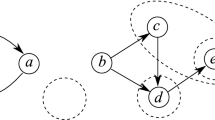Abstract
A tight connection is exhibited between infinite paths in recursive trees and Hamiltonian paths in recursive graphs. A corollary is that determining Hamiltonicity in recursive graphs is highly undecidable, viz, Σ 11 -complete. This is shown to hold even for highly recursive graphs with degree bounded by 3. Hamiltonicity is thus an example of an interesting graph problem that is outside the arithmetic hierarchy in the infinite case.
Similar content being viewed by others
References
R. Aharoni, M. Magidor and R. A. Shore,On the strength of König’s duality theorem for infinite bipartite graphs, manuscript, 1990.
D. R. Bean,Effective coloration, J. Sym. Logic41 (1976), 469–480.
D. R. Bean,Recursive Euler and Hamiltonian paths, Proc. Am. Math. Soc.55 (1976), 385–394.
R. Beigel and W. I. Gasarch, unpublished results, 1986–1990.
R. Beigel and W. I. Gasarch,On the complexity of finding the chromatic number of a recursive graph, Parts I & II, Ann. Pure and Appl. Logic45 (1989), 1–38, 227–247.
S. A. Burr,Some undecidable problems involving the edge-coloring and vertex coloring of graphs, Disc. Math.50 (1984), 171–177.
W. I. Gasarch and M. Lockwood,The existence of matchings for recursive and highly recursive bipartite graphs, Technical Report 2029, Univ. of Maryland, May 1988.
W. I. Gasarch, Personal communication, 1991.
D. Harel,Effective transformations on infinite trees, with applications to high undecidability, dominoes and fairness, J. Assoc. Comput. Mach.33 (1986), 224–248.
A. Manaster and J. Rosenstein,Effective matchmaking (recursion theoretic aspects of a theorem of Philip Hall), Proc. London Math. Soc.3 (1972), 615–654.
A. Nerode and J. Remmel,A survey of lattices of R. E. substructures, in Recursion Theory, Proc. Symp. in Pure Math., Vol. 42 (A. Nerode and R. A. Shore, eds.), Am. Math. Soc., Providence, R. I., 1985, pp. 323–375.
H. Rogers,Theory of Recursive Functions and Effective Computability, McGraw-Hill, New York, 1967.
Author information
Authors and Affiliations
Corresponding author
Additional information
Parts of this research were carried out during a visit to IBM T.J. Watson Research Center, Hawthorne, NY, in the Summer of 1990. The author holds the William Sussman Professorial Chair in Mathematics.
Rights and permissions
About this article
Cite this article
Harel, D. Hamiltonian paths in infinite graphs. Israel J. Math. 76, 317–336 (1991). https://doi.org/10.1007/BF02773868
Received:
Revised:
Issue Date:
DOI: https://doi.org/10.1007/BF02773868




